管理学课件第16章 激励员工Motivating Employees
管理学—员工激励英文

© 2007 Prentice Hall, Inc. All rights reserved.
16–7
Exhibit 16–1 Maslow’s Hierarchy of Needs
© 2007 Prentice Hall, Inc. All rights reserved.
16–8
Early Theories of Motivation (cont’d)
• McGregor’s Theory X and Theory Y
➢ Theory X
❖ Assumes that workers have little ambition, dislike work, avoid responsibility, and require close supervision.
• Describe Herzberg’s motivation-hygiene theory. • Explain Herzberg’s views of satisfaction and
dissatisfaction.
© 2007 Prentice Hall, Inc. All rights reserved.
Early Theories of Motivation
• Describe Maslow’s hierarchy of needs and how it can be used to motivate.
• Discuss how Theory X and Theory Y managers approach motivation.
• Maslow’s Hierarchy of Needs Theory
➢ Needs were categorized as five levels of lower- to higher-order needs.
《管理学》第9版 第16章 激励员工
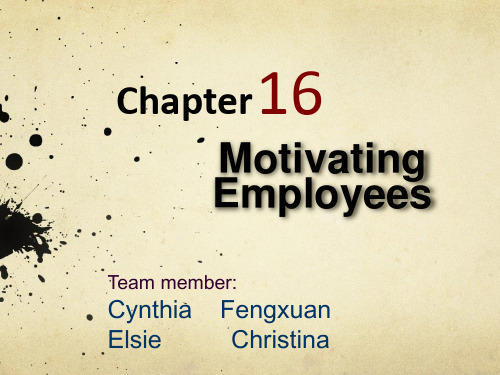
incorrect view motivation as personal trail Motivation--Motivation--- refers to the process by which a person’s efforts are energized, directed, and sustained toward attaining a goal. Three key elements: energy, direction, and persistence.
Distributive justice Procedural justice
Contemporary Theories of Motivation
Expectancy Theory
States that an individual tends to act in a certain way based on the expectation that the act will be followed by a given outcome and on the attractiveness of that outcome to the individual. individual.
Early theories of motivation
traditional view
Satisfied Dissatisfied
Herzberg’s view
Motivators Satisfaction No satisfaction Hygiene factors No dissatisfaction Dissatisfaction
V{tÑàxÜ
16
Motivating Employees
管理学第16章激励员工

❖ 假设工人没有雄心大志、不喜欢工作、逃避责任以及需要严格 监控
➢ Y理论
❖ 假设工人可以自我指导、主动寻求工作责任、喜欢工作,他们 接受甚至主动寻求工作责任,他们把工作视为一项自然而然的 活动。
➢ 假设: X理论假设较低层级的需要支配着个人行为,Y理 论假设较高层级的需要支配着个人行为。
用
16–3
什么是动机?
• 动机
➢ 动机是人与环境交互作用的结果;它并不是人的特性 ➢ 它是一个人为达到一个目标所付出的努力得到加强、
管理和持续的过程
❖ 强度: 一个强烈程度和驱动力的测量指标 ❖ 方向: 朝向组织目标 ❖ 坚持性: 竭尽全力实现目标.
➢ 但个体的需要组织的目标一致时激励最有效
16–4
• 个体希望通过高水平的努力而实现组织目标的愿 望,其前提条件是这种努力能够满足个体的某些 需要。
• 无论是激励还是动机,都包括三个要素: 努力、组织目标和需要。 一般而言,动机是指诱发、活跃、推 动并引导行为指向一定目标的心理过程。 激励是指影响人们的内在需求或动机, 从而加强、引导和维持行为的活动或过程。
❖ Need of 归属affiliation (nAff) – The desire for interpersonal relationships
16–16
• 成就需要 高成就需要者追求的是个人成就感 高成就需要者未必是一个优秀的管理者,因为高 成就需要者关注自己的成就,优秀管理者应重视 帮助他人实现自己的目标 通过培训可以激发员 工的成就需要
16–5
• 动机过程: 未满足的需要-紧张感-驱力-寻求行为-需要获
得满足-紧张解除。
16–6
早期的动机理论
• 马斯洛的需求层次理论 • 麦格雷戈的X理论和Y理论 • 赫茨伯格的双因素理论
管理学原理ChMotivatingEmployeesPPT课件
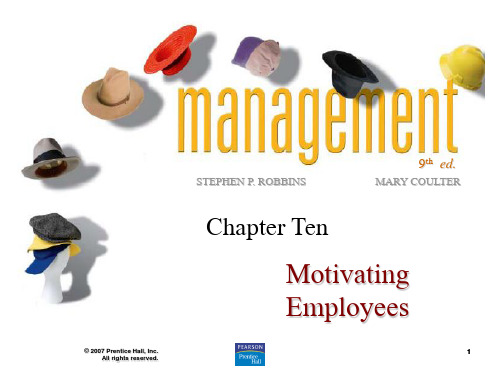
➢ He suggested that management could use either set of needs to motivate employees
8
?needforachievementnach?thedrivetoexcelandsucceed?preferpersonalresponsibilityinterdependenceworkingalonebutnotinteammoderatelydifficulttaskselfgeneratedfeedback?matchnotnecessarilygoodmanagerssuccessfulentrepreneurs16?needforaffiliationnaff?thedesireforpositiveinterpersonalrelationshipsavoidconflictandconfrontation?supportothersandsmoothoutconflicts?matchbestmanagerslowiniteffectiveincoordinatingrolesandsalespositionwithlongtermrelationindecisiveinallocatingscareresourcesordecisionspotentiallygeneratingconflicts17?needforpowernpow?theneedtoinfluencethebehaviorofothers?wanttoexercisecontrolmaintainleadershipposition?typespersonalpowerfulfillpersonalneedsocializedpowerservestakeholders?matchbestmanagershighinitcorporateandpoliticalleaders18implications?thethreeneedsarelearnednotinstinctivethuscouldbetrainedviamotivatingprogram?nachstrengthened?balancethedriveofcompetitionandcooperation?rewardsforbothindividualandteamwork?differentiate?differentpeoplehavedifferentneeds?peoplehavedifferentneedsatdifferenttimes?o
管理学英文版课间激励MotivatingEmployees精品文档
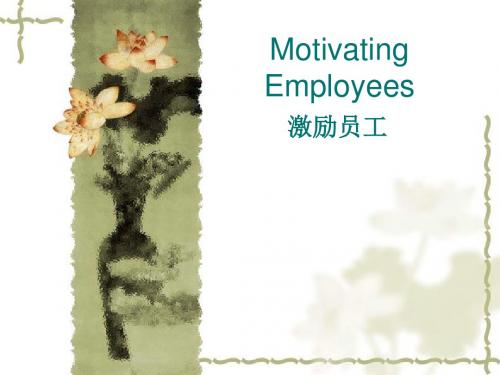
19
Motivation and Goals
Goal-Setting Theory
Proposes that setting goals that are accepted, specific, and challenging yet achievable will result in higher performance than having no or easy goals.
gets feedback on their progress
MacGregor’s Theories X and Y 麦格雷戈的X and Y理论
Herzberg’s Motivation-Hygiene Theory 赫茨伯 格的激励-保健理论
10
Main points
1.There is a hierarchy of 5 needs. 2.A.Individuals must satisfy lower-
• Describe the five levels in Maslow’s hierarchy and how Maslow’s hierarchy can be used in motivational efforts.
• Discuss how Theory X and Theory Y managers approach motivation.
• Discuss the challenges managers face in motivating unique groups of workers.
• Describe open-book management and employee recognition, pay-for-performance, and stock option programs.
Motivating-Employees-Chapter16-激励雇员-PPT
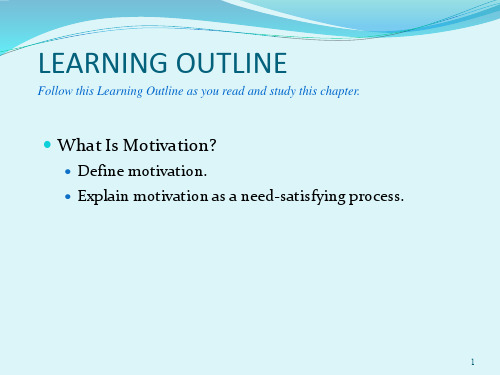
Personal and Work Outcomes
High Internal Work Motivation
High-Quality Work Performance
High Satisfaction with the Work
Low Absenteeism and Turnover
17
Guidelines for Job Redesign
Motivators: intrinsic 固有 (psychological) factors that create job satisfaction
Attempted to explain why job satisfaction 满意 does not result in increased performance
1
LEARNING OUTLINE
Early Theories
Maslow hierarchy of needs
Describe the five levels
McGregor’s X&Y Herzberg’s Two-Factors
views of satisfaction and dissatisfaction
Maslow’s Hierarchy of Needs Theory
Motivating_Employees_Chapter16_激励雇员_PPT-36页PPT资料

Needs were categorized as five levels
Satisfy lower-order needs before they can satisfy higher order needs
Satisfied needs do not motivate Know what level each person is on
Motivators
Hygiene Factors
Satisfaction
No Satisfaction
No Dissatisfaction
Dissatisfaction
13
Contemporary Theories: 3 Needs
Contemporary Theories: Reinforcement Theory
Current Issues in Motivation
Describe the cross-cultural challenges of motivation. Discuss the challenges managers face in motivating
unique groups of employees. Describe open-book management and emploபைடு நூலகம்ee
Theory Y
Employees can exercise self-direction, desire responsibility, and like to work
Motivation is maximized by participative decision making, interesting jobs, and good group relations
罗宾斯《管理学》第七版第十六章 激励员工
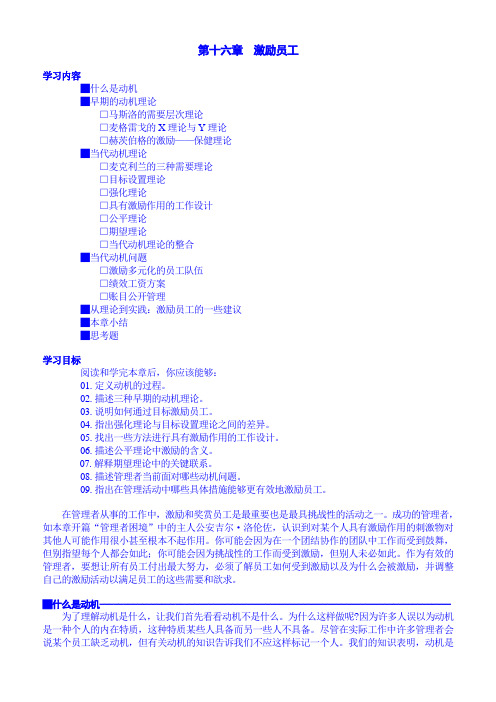
第十六章激励员工学习内容█什么是动机█早期的动机理论□马斯洛的需要层次理论□麦格雷戈的X理论与Y理论□赫茨伯格的激励——保健理论█当代动机理论□麦克利兰的三种需要理论□目标设置理论□强化理论□具有激励作用的工作设计□公平理论□期望理论□当代动机理论的整合█当代动机问题□激励多元化的员工队伍□绩效工资方案□账目公开管理█从理论到实践:激励员工的一些建议█本章小结█思考题学习目标阅读和学完本章后,你应该能够:01.定义动机的过程。
02.描述三种早期的动机理论。
03.说明如何通过目标激励员工。
04.指出强化理论与目标设置理论之间的差异。
05.找出一些方法进行具有激励作用的工作设计。
06.描述公平理论中激励的含义。
07.解释期望理论中的关键联系。
08.描述管理者当前面对哪些动机问题。
09.指出在管理活动中哪些具体措施能够更有效地激励员工。
在管理者从事的工作中,激励和奖赏员工是最重要也是最具挑战性的活动之一。
成功的管理者,如本章开篇“管理者困境”中的主人公安吉尔·洛伦佐,认识到对某个人具有激励作用的刺激物对其他人可能作用很小甚至根本不起作用。
你可能会因为在一个团结协作的团队中工作而受到鼓舞,但别指望每个人都会如此;你可能会因为挑战性的工作而受到激励,但别人未必如此。
作为有效的管理者,要想让所有员工付出最大努力,必须了解员工如何受到激励以及为什么会被激励,并调整自己的激励活动以满足员工的这些需要和欲求。
█什么是动机--------------------------------------------------------------------------为了理解动机是什么,让我们首先看看动机不是什么。
为什么这样做呢?因为许多人误以为动机是一种个人的内在特质,这种特质某些人具备而另一些人不具备。
尽管在实际工作中许多管理者会说某个员工缺乏动机,但有关动机的知识告诉我们不应这样标记一个人。
我们的知识表明,动机是个人与环境相互作用的产物。
管理学—员工激励(英文)--资料

© 2007 Prentice Hall, Inc. All rights reserved.
16–5
Early Theories of Motivation
STEPHEN P. ROBBINS
ninth edition
MARY COULTER
16 Chapter Motivating Employees
© 2007 Prentice Hall, Inc. All rights reserved.
PowerPoint Presentation by Charlie Cook The University of West Alabama
• Explain how goal-setting and reinforcement theories explain employee motivation.
• Describe the job characteristics model as a way to design motivating jobs.
Early Theories of Motivation
• Describe Maslow’s hierarchy of needs and how it can be used to motivate.
• Discuss how Theory X and Theory Y managers approach motivation.
• Discuss the motivation implications of equity theory.
管理学激励PPT课件

有人做过这样的调查:按时计酬的职工每天 一般只需发挥20%-30%的能力用于工作就足 以保住饭碗。但是如果能充分调动其积极性, 那么他们的潜力会发挥到80%-90%,这之间 的差额用于提高劳动生产率,其效果是可观的。 这需依靠有效的激励!
2
教学目标与要求
➢ 理解激励的概念与激励原理 ➢ 了解激励产生的外因与内因 ➢ 了解需要的意义 ➢ 理解和掌握X理论与Y理论的内容 ➢ 掌握内容型激励理论和过程型激励理论的内容 ➢ 掌握强化理论 ➢ 了解当代激励实务的一般做法
29
保健因素:
这类因素处理的不好会引发 工作不满情绪的产生,处理的好 可预防和消除这种不满。但它不 能起激励作用,只能起到保持人 的积极性,维持工作现状的作用。
激励因素:
促使人因素
避免员工产生不满情绪
工资 监督 地位 安全 工作环境 政策与管理制度 人际关系
3
教学重点与难点
➢激励的概念 ➢激励的原理 ➢X理论与Y理论的内容 ➢需要层次理论 ➢双因素理论 ➢公平理论 ➢期望理论 ➢强化理论
4
事例:
(1)强渡大渡河,飞夺泸定桥。 (2)上甘岭。 (3)中国女排与中国男足。
5
在工作现场,员工们并不一定以同样的进度 和工作主动性开展活动。-----在对工作上的动 机方面,员工之间是存在有差别的。
控制欲望
工作本身,关注成功 领导过程,支 的过程而不仅仅是成 配他人 功的结果
能够独立处理问题, 有竞争性和能
及时反馈信息、中度 够体现地位的
风险的环境
环境
建立友好亲 密的人际关 系的愿望
交往过程, 被人喜欢和 接纳
合作而不是 竞争的环境。
35
5.目标设置理论 观点:具体的目标会提高工作成绩。困难的
马工程管理学 第16章 激励员工

➢工作设计方法的再设计 关系取向的工作设计观(relational perspective of work design ):关注于员工的任务和工作如何日益依赖于各种社会关系
主动的工作设计观(proactive perspective of work design):认 为员工正在积极主动地改变自己的工作方式,他们更多地参与 对其工作具有影响的决策和行动
核心工作维度
技能多样性 任务完整性 任务重要性
工作自主性
工作反馈
工作特征模型
关键心理状态
体验到工作的意义
体验到对工作 结果的责任 对于工作活动 实际结果的了解
员工增长需要强度
个人与工作结果 高内部工作动机 高质量的工作绩效 对工作的高满意度 低缺勤率和流动率
管理者进行工作设计的指导原则
建议活动
核心工作维度
➢工作特征模型 (job characteristic model, JCM) 技能多样性(skill variety):指一项工作需要从事多种活动从而使 员工能够利用各种不同技能和才干的程度。 任务完整性(task identity):指一项工作中要求完成一件完整 的和可辨识的工作任务的程度。 任务重要性(task significance):指一项工作对他人生活和工作的 实际影响程度。 工作自主性(autonomy):指一项工作在安排工作内容、确定 工作程序方面,实际上给员工多大的自由度、独立权及决定权。 工作反馈(feedback):指员工在完成任务的过程中,可以获得 关于自己工作绩效的直接而明确的信息的程度。
➢ 2.妈妈为了激励小明提高成绩,提出如果他期末考试进了全 班前十名,就免去他每周末洗碗的任务。(负强化)
➢ 3.妈妈提出,如果小明期末考试没进全班前十名,寒假就 没有压岁钱。(惩罚)
MotivatingEmployees激励雇员PPT
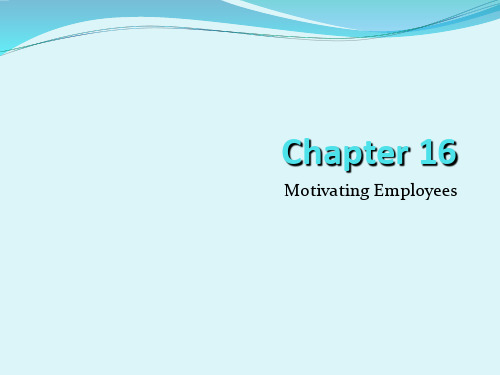
From Theory To Practice: Suggestions
5
Wtting employees energized, directed, and sustained towards reaching the goal
Hierarchy of needs
Lower-order (external): physiological, safety Higher-order (internal): social, esteem, self-
actualization
8
Maslow’s Hierarchy of Needs 自我实现
When inequities occur, employees will attempt to do something to rebalance the ratios (seek justice)
Motivators: intrinsic 固有 (psychological) factors that create job satisfaction
Attempted to explain why job satisfaction 满意 does not result in increased performance
Chapter 16
Motivating Employees
LEARNING OUTLINE
Follow this Learning Outline as you read and study this chapter.
What Is Motivation?
罗宾斯管理学激励Motivatingemployees

2.2 McGregor’s Theory X and Theory Y
麦格雷戈X理论和Y理论
➢Theory X
❖ Assumes that workers have little ambition, dislike work, avoid responsibility, and require close supervision.
❖ Hygiene factors 保健因素: extrinsic (environmental) factors that create job dissatisfaction.
❖ Motivators 激励因素: intrinsic (psychological) factors that create job satisfaction.
❖ Individuals must satisfy lower-order needs before they can satisfy higher order needs.
❖ Satisfied needs will no longer motivate. ❖ Motivating a person depends on knowing at what level
• Personal responsibility, feedback on performance, too easy or too difficult work; nAch manager≠ good manager
❖ Need for power (nPow) 权力需要 – The need to influence the behavior of others
15–8
2.1 Maslow’s Hierarchy of Needs Theory
- 1、下载文档前请自行甄别文档内容的完整性,平台不提供额外的编辑、内容补充、找答案等附加服务。
- 2、"仅部分预览"的文档,不可在线预览部分如存在完整性等问题,可反馈申请退款(可完整预览的文档不适用该条件!)。
- 3、如文档侵犯您的权益,请联系客服反馈,我们会尽快为您处理(人工客服工作时间:9:00-18:30)。
Hygiene factors(保健因素 ): extrinsic (environmental) factors that create job dissatisfaction. Motivators(激励因素 ): intrinsic (psychological) factors that create job satisfaction.
ninth edition
STEPHEN P. ROBBINS
MARY COULTER
Chapter
16
Motivating Employees
PowerPoint Presentation by Charlie Cook The University of West Alabama
LEARNING OUTLINE
• Describe open-book management, employee recognition, pay-for-performance, and stock option programs.
16–4
What Is Motivation?(什么是激励)
• Motivation(激励)
Is the result of an interaction between the person and a situation; it is not a personal trait. Is the process by which a person’s efforts are energized, directed, and sustained towards attaining a goal.
• Expectancy Theory(期望理论)
16–13
Motivation and Needs
• Three-Needs Theory (McClelland)
There are three major acquired needs that are major motives in work.
Early Theories of Motivation
• Describe Maslow’s hierarchy of needs and how it can be used to motivate. • Discuss how Theory X and Theory Y managers approach motivation. • Describe Herzberg’s motivation-hygiene theory. • Explain Herzberg’s views of satisfaction and dissatisfaction.
16–2
L E A R N I N G O U T L I N E (cont’d)
Follow this Learning Outline as you read and study this tivation
• Describe the three needs McClelland proposed as being present in work settings. • Explain how goal-setting and reinforcement theories explain employee motivation. • Describe the job characteristics model as a way to design motivating jobs. • Discuss the motivation implications of equity theory. • Contrast distributive justice and procedural justice. • Explain the three key linkages in expectancy theory and their role in motivation.
Follow this Learning Outline as you read and study this chapter.
What Is Motivation?
• Define motivation. • Explain motivation as a need-satisfying process.
Hierarchy of needs
Lower-order (external)(低级的需要 ): physiological, safety (生理需要,安全需要 ) Higher-order (internal)(高级的需要 ): social, esteem, selfactualization(社交需要 ,尊重需要 ,自我实现需要 )
16–7
Exhibit 16–1
Maslow’s Hierarchy of Needs
16–8
Early Theories of Motivation (cont’d)
• McGregor’s Theory X and Theory Y(麦格雷戈工 X理论和Y理论) • Theory X( X理论 )
16–3
L E A R N I N G O U T L I N E (cont’d)
Follow this Learning Outline as you read and study this chapter.
Current Issues in Motivation
• Describe the cross-cultural challenges of motivation. • Discuss the challenges managers face in motivating unique groups of workers.
Assumes that workers have little ambition, dislike work, avoid responsibility, and require close supervision. Theory Y( Y理论 )
Assumes that workers can exercise self-direction, desire responsibility, and like to work. Motivation is maximized by participative decision making, interesting jobs, and good group relations.
16–6
Early Theories of Motivation(早期的激励理论)
• Maslow’s Hierarchy of Needs Theory(马斯洛的 需要层次论)
Needs were categorized as five levels of lower- to higher-order needs.
Need for achievement (nAch)(成就需要 ) – The drive to excel and succeed
Need for power (nPow)(权利需要 )
– The need to influence the behavior of others Need of affiliation (nAff)(归属需要 ) – The desire for interpersonal relationships
Individuals must satisfy lower-order needs before they can satisfy higher order needs. Satisfied needs will no longer motivate. Motivating a person depends on knowing at what level that person is on the hierarchy.
16–15
Exhibit 16–5
Goal-Setting Theory
16–16
Motivation and Behavior
• Benefits of Participation in Goal-Setting(参与设 定目标的好处)
Increases the acceptance of goals. Fosters commitment to difficult, public goals. Provides for self-feedback (internal locus of control) that guides behavior and motivates performance (selfefficacy).
16–9
Assumption:
Early Theories of Motivation (cont’d)
• Herzberg’s Motivation-Hygiene Theory(赫兹伯格 的双因素理论)
Job satisfaction and job dissatisfaction are created by different factors.
16–10
Exhibit 16–2
Herzberg’s Motivation-Hygiene Theory
16–11
Exhibit 16–3
Contrasting Views of Satisfaction-Dissatisfaction
16–12
Contemporary Theories of Motivation
16–14
Motivation and Goals
• Goal-Setting Theory(目标设定理论)
Proposes that setting goals that are accepted, specific, and challenging yet achievable will result in higher performance than having no or easy goals. Is culture bound to the U.S. and Canada.
